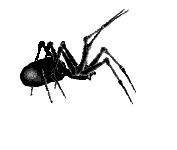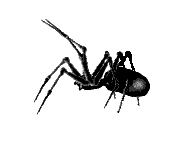





Case Study I: The Spruce-fir
Moss Spider
 The
spruce-fir moss spider (Microhexura montivaga) is a tiny (3-5 mm
adult size) mygalomorph spider (a group of spiders commonly called 'tarantulas')
that is restricted to moist but well-drained moss mat habitats in high-elevation
spruce-fir forests of southern Appalachia (Harp
1992).
The
spruce-fir moss spider (Microhexura montivaga) is a tiny (3-5 mm
adult size) mygalomorph spider (a group of spiders commonly called 'tarantulas')
that is restricted to moist but well-drained moss mat habitats in high-elevation
spruce-fir forests of southern Appalachia (Harp
1992).  The
exotic balsam wooly adelgid (Adelges piceae) is decimating the these
spruce-fir forests, decreasing the forest canopy, which provides vital
cover for the spider's sensitive moss mat habitat (Fridell
1995). Acid rain has been proposed as an additional factor contributing
to the decline of the Appalachian spruce-fir forests. The spider was listed
as endangered under the U.S. Endangered Species Act in February 1995, after
exhaustive assessments of population size and distribution revealed only
four sites that harbored the species with only one relatively stable population
identified (Fridell 1995). Another population has recently been discovered
by a group led by Dr.
F. Coyle of Western Carolina University (J. Harp, personal communication
1996). A draft Recovery Plan has been completed, and major challenges to
conservation include the complex threats to the spider's fragile habitat
and limited information on the natural history, ecology, and genetics of
the species.
The
exotic balsam wooly adelgid (Adelges piceae) is decimating the these
spruce-fir forests, decreasing the forest canopy, which provides vital
cover for the spider's sensitive moss mat habitat (Fridell
1995). Acid rain has been proposed as an additional factor contributing
to the decline of the Appalachian spruce-fir forests. The spider was listed
as endangered under the U.S. Endangered Species Act in February 1995, after
exhaustive assessments of population size and distribution revealed only
four sites that harbored the species with only one relatively stable population
identified (Fridell 1995). Another population has recently been discovered
by a group led by Dr.
F. Coyle of Western Carolina University (J. Harp, personal communication
1996). A draft Recovery Plan has been completed, and major challenges to
conservation include the complex threats to the spider's fragile habitat
and limited information on the natural history, ecology, and genetics of
the species.
 To
assess the threats to the spider's habitat by the balsam wooly adelgid,
a monitoring study of the infestation was initiated on the site of the
one viable spruce-fir moss spider population. Early results of this study
indicate that the level of infestation may require a quicker management
response than had been earlier thought (J. Thompson, The
Nature Conservancy, North
Carolina Chapter, personal communication 1996).
To
assess the threats to the spider's habitat by the balsam wooly adelgid,
a monitoring study of the infestation was initiated on the site of the
one viable spruce-fir moss spider population. Early results of this study
indicate that the level of infestation may require a quicker management
response than had been earlier thought (J. Thompson, The
Nature Conservancy, North
Carolina Chapter, personal communication 1996).  Possible
responses to this threat include experimental techniques such as insecticidal
soaping of trees and transplanting of spider populations to uninfested
sites. The effectiveness and viability of these new techniques remains
unknown, however.
Possible
responses to this threat include experimental techniques such as insecticidal
soaping of trees and transplanting of spider populations to uninfested
sites. The effectiveness and viability of these new techniques remains
unknown, however.
Due to its secretive nature, little information has been collected on
feeding and breeding habits, life span, or dispersal  ability
of spruce-fir moss spiders. This lack of knowledge contributes to the difficulty
in relocation and pursuing another conservation technique: captive breeding.
A captive
breeding program was initiated in 1992 at the Louisville Zoological
Park, and while techniques in maintaining the species in captivity have
advanced, successful long-term captivity and reproduction has not yet occurred
(J. Harp, personal communication 1996). Proper techniques might need to
be learned through the use of a related, non-endangered species, M.
idahoana.
ability
of spruce-fir moss spiders. This lack of knowledge contributes to the difficulty
in relocation and pursuing another conservation technique: captive breeding.
A captive
breeding program was initiated in 1992 at the Louisville Zoological
Park, and while techniques in maintaining the species in captivity have
advanced, successful long-term captivity and reproduction has not yet occurred
(J. Harp, personal communication 1996). Proper techniques might need to
be learned through the use of a related, non-endangered species, M.
idahoana.